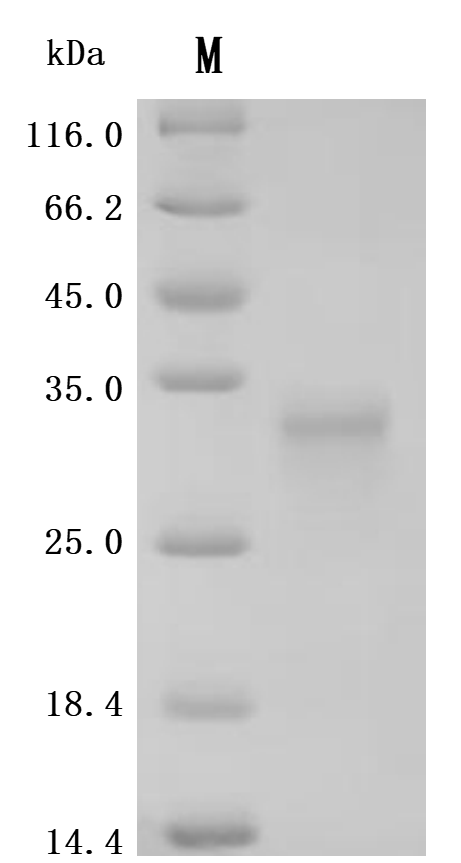The recombinant mouse Tnfsf15 protein is an active form produced in mammalian cells to ensure accurate folding and native post-translational modifications. It consists of amino acids 61 to 252 of the mouse Tnfsf15 sequence, representing the functional extracellular domain. An N-terminal 10xHis tag is included to facilitate purification and detection. Supplied as a lyophilized powder, the recombinant Tnfsf15 protein shows high purity, exceeding 95% as confirmed by SDS-PAGE. Functional ELISA analysis demonstrates its specific binding to the anti-TNFSF15 recombinant antibody (CSB-RA023992MA1HU) when immobilized at 2 μg/mL, with an EC50 value between 1.671 and 2.506 ng/mL. This makes the Tnfsf15 protein a reliable reagent for studies related to cytokine signaling, immune regulation, and therapeutic antibody research targeting Tnfsf15.
The TNFSF15 protein, also known as TL1A, is a member of the TNF superfamily and regulates immune responses and angiogenesis. This protein is primarily expressed in immune cells such as macrophages and T lymphocytes and is implicated in various physiological and pathological processes, particularly inflammation and angiogenesis.
One notable function of TNFSF15 is its ability to inhibit vascular endothelial growth factor (VEGF) production in endothelial cells. Research by Zhang et al. demonstrates that the transfection of mouse TNFSF15 into endothelial cells resulted in significantly reduced VEGF expression, indicating that TNFSF15 serves as an endogenous inhibitor of angiogenesis through its interactions with endothelial cells [1]. Furthermore, the presence of neutralizing antibodies against TNFSF15 abolished its inhibitory effects on VEGF production, confirming its role [1]. Studies indicate that TNFSF15 exerts its anti-angiogenic effects by binding to specific receptors such as death receptor 3 (DR3) and decoy receptor 3 (DcR3), further supporting its role in regulating endothelial cell proliferation and promoting apoptosis in these cells [2][3].
In the context of cancer biology, the downregulation of TNFSF15 is crucial for tumor neovascularization, as demonstrated in studies on ovarian cancer. Tumor-associated macrophages and other immune cells downregulated TNFSF15 to facilitate angiogenesis and promote tumor growth [4]. This relationship highlights the interaction between immune responses and tumor progression, where TNFSF15 appears to act as a checkpoint against uncontrolled neovascularization that typically supports tumor viability [4].
TNFSF15 has also been implicated in modulating immune responses. It enhances the proliferation and differentiation of CD4+ T cells into Th17 cells, which are essential mediators of inflammatory responses [5][6]. This pro-inflammatory role is particularly significant in the context of inflammatory bowel diseases (IBD) such as Crohn's disease and ulcerative colitis, where TNFSF15 is expressed at elevated levels and associated with increased disease severity [7][8]. Specifically, TNFSF15's interaction with DR3 boosts the production of key pro-inflammatory cytokines, including interferon-γ and IL-17, thereby placing TNFSF15 within the inflammatory pathways characterizing IBD [9][8].
References:
[1] K. Zhang, H. Cai, et al. Tnfsf15 suppresses vegf production in endothelial cells by stimulating mir-29b expressionviaactivation of jnk-gata3 signals. Oncotarget, vol. 7, no. 43, p. 69436-69449, 2016. https://doi.org/10.18632/oncotarget.11683
[2] C. Sun, S. Ma, et al. Diagnostic value, prognostic value, and immune infiltration of lox family members in liver cancer: bioinformatic analysis. Frontiers in Oncology, vol. 12, 2022. https://doi.org/10.3389/fonc.2022.843880
[3] M. Yang, Y. Su, et al. Ferroptosis-related lncrnas guiding osteosarcoma prognosis and immune microenvironment. 2023. https://doi.org/10.21203/rs.3.rs-3119479/v1
[4] W. Deng, X. Gu, et al. Down-modulation of tnfsf15 in ovarian cancer by vegf and mcp-1 is a pre-requisite for tumor neovascularization. Angiogenesis, vol. 15, no. 1, p. 71-85, 2011. https://doi.org/10.1007/s10456-011-9244-y
[5] M. Zucchelli, M. Camilleri, et al. Association of tnfsf15 polymorphism with irritable bowel syndrome. Gut, vol. 60, no. 12, p. 1671-1677, 2011. https://doi.org/10.1136/gut.2011.241877
[6] S. Jin, J. Chin, S. Seeber, et al. Tl1a/tnfsf15 directly induces proinflammatory cytokines, including tnfα, from cd3+cd161+ t cells to exacerbate gut inflammation. Mucosal Immunology, vol. 6, no. 5, p. 886-899, 2013. https://doi.org/10.1038/mi.2012.124
[7] F. Ditrich, S. Blümel, et al. Genetic risk factors predict disease progression in crohn’s disease patients of the swiss inflammatory bowel disease cohort. Therapeutic Advances in Gastroenterology, vol. 13, 2020. https://doi.org/10.1177/1756284820959252
[8] K. Baskaran, S. Pugazhendhi, & B. Ramakrishna. Protective association of tumor necrosis factor superfamily 15 (tnfsf15) polymorphic haplotype with ulcerative colitis and crohn's disease in an indian population. Plos One, vol. 9, no. 12, p. e114665, 2014. https://doi.org/10.1371/journal.pone.0114665
[9] M. Hedl and C. Abraham. A tnfsf15 disease-risk polymorphism increases pattern-recognition receptor-induced signaling through caspase-8–induced il-1. Proceedings of the National Academy of Sciences, vol. 111, no. 37, p. 13451-13456, 2014. https://doi.org/10.1073/pnas.1404178111





